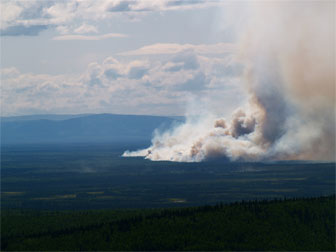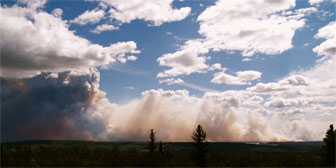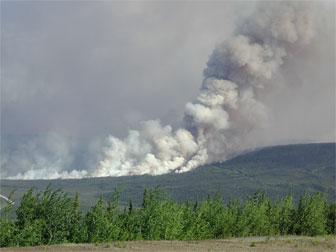Forest fires causing mercury pollution in North America
Forest fires causing mercury pollution in North America
May worsen with global warming
mongabay.com
August 21, 2006
Increasing occurrence and intensity of wildfires due to climate change could worsen mercury pollution in North America according to a new study from researchers at Michigan State University, the U.S. Geological Survey, the National Center for Atmospheric Research, and the Canadian Forest Service. Wildfires are releasing mercury long ago sequestered in Northern wetlands and could add to health problems in the region.
Wildfires threaten mercury stocks in northern soils
Joint Release from the American Geophysical Union and Michigan State University
Climate change appears to be contributing to the
waking of a toxic sleeping giant in the most northern wetlands of
North America. Mercury, released into the atmosphere most
prodigiously with the launching of the industrial age, falls back
onto Earth and accumulates, particularly in North American
wetlands.
Researchers at Michigan State University, the U.S. Geological
Survey, the National Center for Atmospheric Research, and the
Canadian Forest Service find that wildfires, which are becoming
more frequent and intense, are unleashing this sequestered mercury
at levels up to 15 times greater than previously calculated. Their
report was published 19 August in Geophysical Research Letters.
 
Images courtesy of Merritt Turetsky, Michigan State University.
Forest fires have high cost to health |
“This study makes the point that while peat lands are typically
viewed as very wet and stagnant places, they do burn in continental
regions, especially late in the season when water tables are
depressed,” said Merritt Turetsky, lead author of the study. “When
peat lands burn, they can release a huge amount of mercury that
overwhelms regional atmospheric emissions. Our study is new in
that it looks to the soil record to tell us what happens when peat
soil burns, soil that has been like a sponge for mercury for a long
time.”
Normal atmospheric conditions naturally carry the mercury emitted
from burning fossil fuel and other industry northward, where it
eventually settles on land or water surfaces. The cold, wet soils of
the boreal forest region in Alaska and northern Canada have been
efficient in retaining, or sequestering, mercury.
“When we walk across the surface of a peat land, we are standing
on many thousands of years of peat accumulation,” Turetsky said.
“This type of wetland is actually doing us a service. Peat lands
have been storing mercury from the atmosphere since well before
and during the Industrial Revolution, locking it in peat where it’s
not causing any biological harm, away from the food web.”
In addition to industrial activity, climate change also appears to be
disrupting the mercury cycle. Increasingly, northern wetlands are
drying out. Forest fires are burning more frequently, more
intensely, and later in the season, which Turetsky believes will
make peat lands more vulnerable to fire. In May, Turetsky
co-authored with Eric Kasischke of the University of Maryland
another Geophysical Research Letters paper that documented
recent changes in North American fires and proposed that more
frequent summer droughts and severe fire weather have increased
burn areas.
“We are suggesting that environmental mercury is just like a
thermometer. Levels will rise in the atmosphere with climate
change, but due to increasing fire activity in the north and not
solely due to warming, said Jennifer Harden, soil scientist at the
U.S. Geological Survey and a co-author of the study.
In the newly published paper, Turetsky and her co-authors
measured the amount of mercury stored in soils and vegetation of
forests and peat lands, then used historical burn areas and emission
models to estimate how much of that mercury is released to the
atmosphere at a regional scale during fires.
The group studied more than five years of prescribed burns and
natural fires to measure the influence of burning on terrestrial
mercury storage. They also sampled smoke plumes to measure
atmospheric mercury levels as fires blaze.
Their findings indicate that drier conditions in northern regions
will cause soil to relinquish its hold on hundreds of years of
mercury accumulation, sending that mercury back into the air at
levels considerably higher than previously realized.
We’re talking about mercury that has been relatively harmless,
trapped in peat for hundreds of years, rapidly being spewed back
into the air,” Turetsky said. “Some of it will fall back onto soils.
Some will fall into lakes and streams where it could become toxic
in food chains. Our findings show us that climate change is
complex and will contribute to the pollution of food chains that are
very far away from us, in remote regions of the north.”
The research was funded by the U.S. Geological Survey, the
National Center of Atmospheric Research (supported by the
National Science Foundation), and the Electric Power Research
Institute. Turetsky’s work also is supported by Michigan State
University’s Michigan Agricultural Research Station.
|
|
The report notes that consequences of water scarcity are already evident in some of countries. It says that Egypt imports more than half of its food due to a lack of water to grow, while Australia faces major water scarcity in the Murray-Darling Basin as a result of agricultural diversion.
Agriculture is a significant cause of water scarcity in much of the world since crop production requires up to 70 times more water than is used in drinking and other domestic purposes. The report says that a rule of thumb is that each calorie consumed as food requires about one liter of water to produce.
While the report argues that “many difficult choices entailing tradeoffs between city and agriculture users, between food production and the environment, and between fishers and farmers” it says that “the world is not ‘running out’ of water” and that there is enough land, water and human capacity to solve the shortages.
“The Assessment shows that while a third of the world population faces water scarcity, it is not because there is not enough water to go round, but because of choices people make,” Molden said. “It is possible to reduce water scarcity, feed people and address poverty, but the key trade-off is with the environment. People and their governments will face some tough decisions on how to allocate and manage water. Not all situations are going to be a win-win for the parties involved, and in most cases there are winners and losers. If you don’t consciously debate and make tough choices, more people, especially the poor, and the environment will continue to pay the price.”
This article is based on a news release from the International Water Management Institute.
